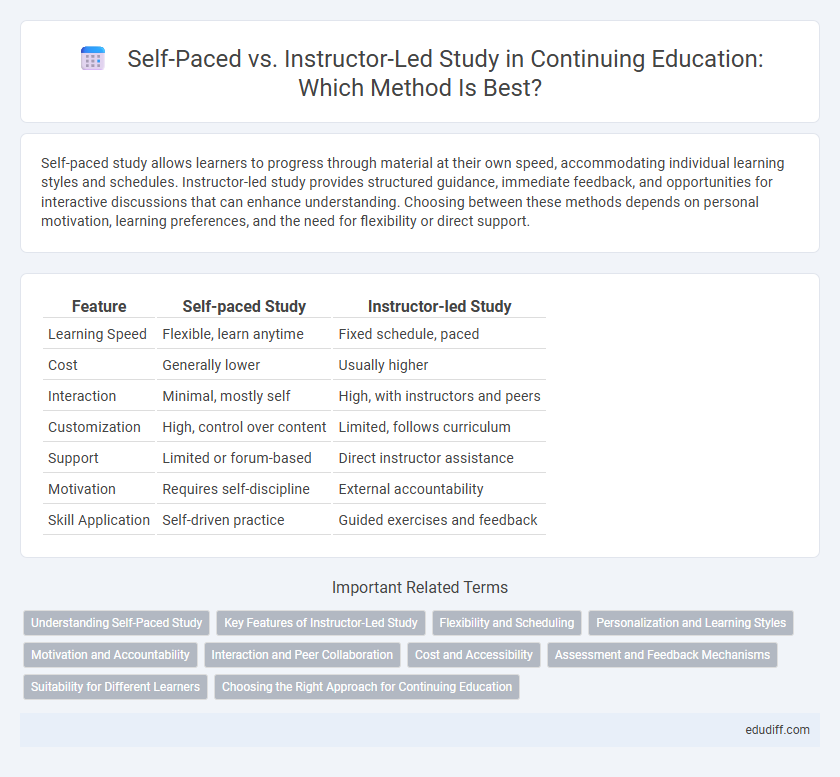Self-paced study allows learners to progress through material at their own speed, accommodating individual learning styles and schedules. Instructor-led study provides structured guidance, immediate feedback, and opportunities for interactive discussions that can enhance understanding. Choosing between these methods depends on personal motivation, learning preferences, and the need for flexibility or direct support.
Table of Comparison
| Feature | Self-paced Study | Instructor-led Study |
|---|---|---|
| Learning Speed | Flexible, learn anytime | Fixed schedule, paced |
| Cost | Generally lower | Usually higher |
| Interaction | Minimal, mostly self | High, with instructors and peers |
| Customization | High, control over content | Limited, follows curriculum |
| Support | Limited or forum-based | Direct instructor assistance |
| Motivation | Requires self-discipline | External accountability |
| Skill Application | Self-driven practice | Guided exercises and feedback |
Understanding Self-Paced Study
Self-paced study allows learners to control their learning speed and schedule, leading to improved retention and flexibility. This approach utilizes digital platforms and resources, enabling access to diverse multimedia content tailored to individual needs. Effective self-paced study fosters autonomy and personalized learning experiences, which can enhance motivation and mastery of the subject matter.
Key Features of Instructor-Led Study
Instructor-led study offers structured learning environments with real-time interaction and immediate feedback from experienced educators. It promotes active engagement through discussions, group activities, and personalized support tailored to individual learner needs. Scheduled sessions and clear timelines ensure consistent progress and accountability throughout the course.
Flexibility and Scheduling
Self-paced study offers unparalleled flexibility, allowing learners to access course materials anytime and progress according to their personal schedules, which is ideal for balancing work, family, and other commitments. Instructor-led study follows a fixed timetable, providing structured sessions that foster real-time interaction but require adherence to specific class times. Choosing between the two depends on individual scheduling needs and the preference for either autonomous learning or guided instruction.
Personalization and Learning Styles
Self-paced study offers personalized learning paths tailored to individual preferences, allowing learners to adapt content and pacing according to their unique learning styles such as visual, auditory, or kinesthetic. Instructor-led study provides guided personalization through real-time feedback and adaptive instruction, catering to diverse learning needs within a structured environment. Both methods enhance engagement by aligning educational strategies with personal learning styles, optimizing knowledge retention and skill acquisition.
Motivation and Accountability
Self-paced study fosters intrinsic motivation by allowing learners to set personalized goals and progress at their own speed, which enhances engagement. Instructor-led study provides structured accountability through regular deadlines and direct feedback, helping maintain consistent effort and focus. Combining both approaches can optimize motivation and accountability, leveraging flexibility alongside external support.
Interaction and Peer Collaboration
Self-paced study offers limited interaction, often isolating learners from real-time discussions and peer collaboration opportunities that enhance understanding and critical thinking. Instructor-led study promotes dynamic interaction through structured dialogues, group activities, and immediate feedback, fostering a collaborative learning environment. Peer collaboration in instructor-led settings strengthens communication skills, encourages diverse perspectives, and supports motivation and accountability among learners.
Cost and Accessibility
Self-paced study typically reduces costs by eliminating commuting, fixed schedules, and instructor fees, making it accessible to learners with limited budgets or irregular availability. Instructor-led study often involves higher expenses due to face-to-face sessions, institutional fees, and resource requirements but offers structured timelines that support accountability. Accessibility in self-paced learning is enhanced through online platforms accessible from any location, whereas instructor-led study may require physical presence or scheduled virtual attendance, potentially limiting learner flexibility.
Assessment and Feedback Mechanisms
Self-paced study offers flexible assessment tools such as quizzes and interactive exercises that provide immediate feedback, enhancing learner autonomy. Instructor-led study incorporates personalized assessments and real-time feedback through discussions and evaluations, fostering deeper understanding and tailored improvement. Both methods leverage varying feedback mechanisms to optimize learner performance and knowledge retention.
Suitability for Different Learners
Self-paced study benefits learners who require flexibility due to varying schedules or prefer to learn independently at their own speed. Instructor-led study suits individuals needing structured guidance, real-time feedback, and interactive discussions to enhance comprehension. Understanding a learner's motivation, time management skills, and preferred learning style is crucial for selecting the most effective study format.
Choosing the Right Approach for Continuing Education
Choosing the right approach for continuing education depends on individual learning preferences and career goals. Self-paced study offers flexibility and allows learners to revisit material at their own speed, ideal for busy professionals balancing multiple commitments. Instructor-led study provides structured guidance and real-time interaction, which can enhance understanding and motivation for complex subjects.
Self-paced Study vs Instructor-led Study Infographic

 edudiff.com
edudiff.com